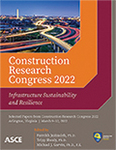Empirical Analysis of Factors Associated with Financial Loss due to Hurricane Harvey
Publication: Construction Research Congress 2022
ABSTRACT
The objective of this research is to find associations between the financial loss per capita caused by the Hurricane Harvey and multiple variables to examine which factors impact the financial loss generated by hurricanes. It is crucial to understand how the characteristics of our living environment are associated with the disaster loss to mitigate the potential damage. This research performs Kendall’s rank correlation analysis using empirical data to identify which variables impacted the financial loss caused by the Hurricane Harvey. To measure the financial loss, this research uses insurance claim payments generated by the Hurricane Harvey in 62 Texas counties. Explanatory variables are selected from multiple fields including hurricane, geological, social, economic, and housing variables to explain the complex nature of disaster financial loss generation. The analysis results suggest that the areas with following features would experience relatively higher financial loss due to hurricanes: being located at where severe storms pass through, experiencing higher rainfall amount, having higher percentage of old housings, having higher median income, being located at lower elevation, and having lower employment rates. This research identifies significant variables that affect the financial loss generated by hurricanes and the magnitudes of the significant variables’ effects. The major contributions of this research to the body of knowledge are finding factors that are associated with financial loss due to hurricanes and identifying places that are more vulnerable to hurricanes than the others.
Get full access to this article
View all available purchase options and get full access to this chapter.
REFERENCES
Burton, C. G. (2010). “Social vulnerability and hurricane impact modeling.” Natural Hazards Review, 11(2), 58–68. doi:https://doi.org/10.1061/(asce)1527-6988(2010)11:2(58).
Carson, D. (n.d.). “Texas Counties: Elevation” Accessed December 15, 2021. http://www.texascounties.net/statistics/elevation.htm.
Choi, O., and Fisher, A. (2003). “The Impacts of Socioeconomic Development and Climate Change on Severe Weather Catastrophe Losses: Mid-Atlantic Region (MAR) and the U.S.” Climatic Change 58, 149–170 doi:https://doi.org/10.1023/A:1023459216609.
Cutter, S., Barnes, L., Berry, M., Burton, C., Evans, E., Tate, E., and Webb, J. (2008). “A place-based model for understanding community resilience to natural disasters.” Global Environmental Change, 18(4), 598e606.
Cutter, S., Boruff, B., and Shirley, L. (2003). “Social vulnerability to environmental hazards.” Social Science Quarterly, 84(2), 242–261.
Cutter, S., Burton, C., and Emrich, C. (2010). “Disaster resilience indicators for benchmarking baseline conditions.” Journal of Homeland Security and Emergency Management, 7(1).
Cutter, S., and Emrich, C. (2005). “Are natural hazards and disaster losses in the u.s. increasing?” Eos, Transactions American Geophysical Union, 86(41), 381. https://doi.org/10.1029/2005eo410001.
Frazier, T., Thompson, C., Dezzani, R., and Butsick, D. (2013). “Spatial and temporal quantification of resilience at the community scale.” Appl Geogr 42:95–107.
Hallegatte, S., Vogt-Schilb, A., Bangalore, M., and Rozenberg, J. (2017). Climate Change and Development Series: Unbreakable; Building the resilience of the poor in the face of natural disasters. World Bank. doi:https://doi.org/10.1596/978-1-4648-1003-9.
Henry, M., Kawasaki, A., Takigawa, I., and Meguro, K. (2017). “The impact of income disparity on vulnerability and information collection: an analysis of the 2011 Thai Flood.” Journal of Flood Risk Management, 10(3), 339–348.
Hummell, B., Cutter, S., and Emrich, C. (2016). “Social Vulnerability to Natural Hazards in Brazil”. International Journal of Disaster Risk Science. 7, 111–122.
Kahn, M. E. (2005). “The death toll from natural disasters: The role of income, geography, and institutions.” Review of Economics and Statistics 87 (2), 271–284.
Kim, J. M., Woods, P., Park, Y. J., Kim, T., and Son, K. (2016) “Predicting hurricane wind damage by claim payout based on Hurricane Ike in Texas”, Geomatics, Natural Hazards and Risk, 7:5, 1513–1525
Morrow, B. (2008). “Community resilience: a social justice perspective.”. Oak Ridge: Community and Regional Resilience Institute.
Morrow, B. (1999). “Identifying and Mapping Community Vulnerability.” Disasters 23(1):11–18.
National Oceanic and Atmospheric Administration Weather Prediction Center. (2017). “Tropical cyclone report: Hurricane Harvey.” Accessed April 3, 2021. https://www.nhc.noaa.gov/data/tcr/AL092017_Harvey.pdf.
National Oceanic and Atmospheric Administration. (2021). “Saffir-Simpson Hurricane Wind Scale.” Accessed April 3, 2021.https://www.nhc.noaa.gov/aboutsshws.php.
National Weather Service. (2017). “Major Hurricane Harvey - August 25-29, 2017.” Accessed April 3, 2021. https://www.weather.gov/crp/hurricane_harvey.
Norris, F., Stevens S., Pfefferbaum, B., Wyche, K., and Pfefferbaum, R. (2008). “Community resilience as a metaphor, theory, set of capacities, and strategy for disaster readiness.” American Journal of Community Psychology 41: 127–150.
Pielke, R. A., Gratz, J., Landsea, C. W., Collins, D., Saunders, M. A., and Musulin, R. (2008). “Normalized hurricane damage in the United states: 1900–2005.” Natural Hazards Review, 9(1), 29–42. doi:https://doi.org/10.1061/(asce)1527-6988(2008)9:1(29).
Rappaport, E. N. (2014). “Fatalities in the United States from Atlantic Tropical Cyclones: New Data and Interpretation.” Bulletin of the American Meteorological Society, 95(3), 341–346. doi:https://doi.org/10.1175/bams-d-12-00074.1.
Texas Department of Insurance. (2018). Hurricane Harvey Data Call. Accessed April 3, 2021. https://www.tdi.texas.gov/reports/documents/harvey-dc-04252019.pdf.
Washington, S., Karlaftis, M., and Mannering, F. (2010). Statistical and Econometric Methods for Transportation Data Analysis (2nd ed.). Chapman and Hall/CRC.
Zhang, W., Villarini, G., Vecchi, G. A., and Smith, J. A. 2018. “Urbanization exacerbated the rainfall and flooding caused by hurricane Harvey in Houston.” Nature, 563(7731), 384–388. doi:10.1038/s41586-018-0676-z.
Information & Authors
Information
Published In
History
Published online: Mar 7, 2022
Authors
Metrics & Citations
Metrics
Citations
Download citation
If you have the appropriate software installed, you can download article citation data to the citation manager of your choice. Simply select your manager software from the list below and click Download.
